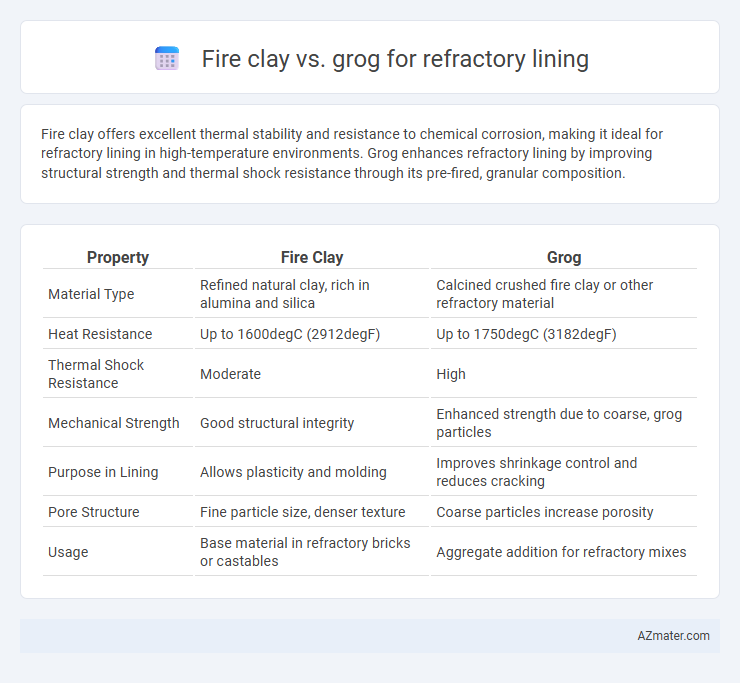Fire clay offers excellent thermal stability and resistance to chemical corrosion, making it ideal for refractory lining in high-temperature environments. Grog enhances refractory lining by improving structural strength and thermal shock resistance through its pre-fired, granular composition.
Table of Comparison
| Property | Fire Clay | Grog |
|---|---|---|
| Material Type | Refined natural clay, rich in alumina and silica | Calcined crushed fire clay or other refractory material |
| Heat Resistance | Up to 1600degC (2912degF) | Up to 1750degC (3182degF) |
| Thermal Shock Resistance | Moderate | High |
| Mechanical Strength | Good structural integrity | Enhanced strength due to coarse, grog particles |
| Purpose in Lining | Allows plasticity and molding | Improves shrinkage control and reduces cracking |
| Pore Structure | Fine particle size, denser texture | Coarse particles increase porosity |
| Usage | Base material in refractory bricks or castables | Aggregate addition for refractory mixes |
Introduction: Understanding Refractory Lining Materials
Fire clay and grog are essential materials for refractory lining, each offering unique thermal and mechanical properties. Fire clay, rich in alumina and silica, provides excellent thermal shock resistance and plasticity, making it ideal for castable and shaped refractories. Grog, consisting of pre-fired crushed fire clay or other refractory materials, enhances strength and reduces shrinkage in refractory linings by improving dimensional stability during high-temperature cycles.
What is Fire Clay? Properties and Uses
Fire clay is a heat-resistant material composed mainly of kaolinite, known for its high alumina content and excellent thermal stability up to 1600degC (2912degF). It exhibits strong refractory properties such as resistance to thermal shock, chemical inertness, and plasticity, making it ideal for forming bricks, castables, and other linings in furnaces, kilns, and incinerators. Fire clay's primary uses include refractory linings in industries like steelmaking, glass production, and ceramics, where durability and insulation against extreme heat are essential.
What is Grog? Composition and Characteristics
Grog is a refractory aggregate made from crushed and ground fired clay or shale, commonly used in refractory linings to enhance thermal stability and reduce shrinkage. Its composition primarily consists of alumina (Al2O3) and silica (SiO2), resulting from the fired raw materials, which imparts high refractoriness, low thermal expansion, and increased mechanical strength. Grog particles provide a coarse, porous structure that improves thermal shock resistance and dimensional stability in high-temperature applications, making it a vital component alongside fire clay in refractory mixes.
Fire Clay vs Grog: Key Differences
Fire clay consists primarily of alumina and silica, offering excellent plasticity and heat resistance ideal for forming dense, smooth refractory linings, while grog is pre-fired, crushed fire clay or other refractory material that enhances thermal shock resistance and reduces shrinkage in the lining. Fire clay's fine particle size allows for precise shaping and bonding in refractory applications, whereas grog's coarse texture improves mechanical strength and porosity control. Choosing between fire clay and grog impacts the refractory lining's durability, heat tolerance, and structural integrity under high-temperature industrial conditions.
Thermal Resistance Comparison
Fire clay offers thermal resistance typically ranging from 1,600degC to 1,750degC, making it suitable for moderate high-temperature applications in refractory linings. Grog, composed of calcined fire clay particles, enhances thermal shock resistance and can withstand temperatures up to 1,800degC or higher, providing improved durability under cyclic heating conditions. The incorporation of grog in refractory linings significantly improves thermal stability and reduces shrinkage, outperforming pure fire clay in maintaining structural integrity at elevated temperatures.
Mechanical Strength and Durability
Fire clay exhibits excellent mechanical strength and thermal stability, making it ideal for refractory linings exposed to high temperatures and thermal cycling. Grog, composed of pre-fired clay particles, enhances the refractory's durability by improving thermal shock resistance and reducing shrinkage during firing. Combining fire clay with grog yields a refractory lining with superior mechanical strength and long-lasting durability under harsh industrial conditions.
Workability and Installation Ease
Fire clay offers superior workability due to its fine particle size and smooth texture, facilitating easier molding and shaping during refractory lining installation. Grog, composed of pre-fired, crushed refractory material, provides better dimensional stability but can be coarser, making it less workable and more challenging to install precisely. The choice between fire clay and grog impacts labor efficiency, with fire clay typically enabling faster installation thanks to its cohesive and pliable nature.
Cost-effectiveness of Fire Clay and Grog
Fire clay offers a cost-effective option for refractory linings due to its abundant availability and lower processing costs compared to grog. Grog, while providing superior thermal shock resistance and mechanical strength, often incurs higher expenses because of its specialized manufacturing and sourcing requirements. Selecting fire clay can reduce material costs without significantly compromising performance in applications with moderate thermal demands.
Best Applications for Fire Clay
Fire clay offers excellent thermal stability and plasticity, making it ideal for refractory linings in high-temperature applications like kilns, furnaces, and fireboxes. Its fine particle size and alumina content ensure strong bonding and resistance to thermal shock, outperforming grog in dynamic heating environments. Fire clay is best suited for shapes and molded components requiring precise form and durable heat resistance.
Ideal Uses of Grog in Refractory Lining
Grog is ideal for refractory lining due to its excellent thermal shock resistance, mechanical strength, and dimensional stability, making it suitable for high-temperature environments like furnaces and kilns. Its coarse texture enhances the refractory mix's resistance to cracking and abrasion, improving the durability and lifespan of linings in steelmaking and glass melting applications. Unlike fire clay, grog provides superior resistance to thermal cycling, making it essential for linings exposed to severe thermal fluctuations.

Infographic: Fire clay vs Grog for Refractory lining
 azmater.com
azmater.com